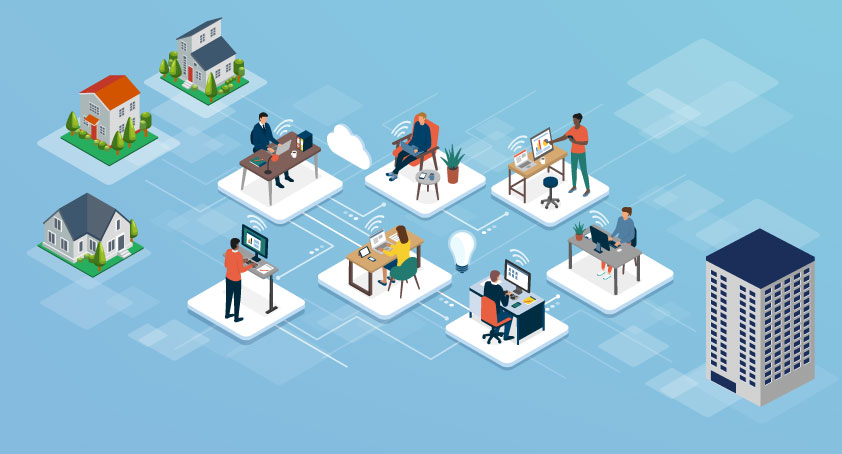How to Safely Return to the Office after COVID-19

Businesses across the country are finally starting to return to their offices. However, many business owners and employees are still concerned about the potential dangers.
There are a number of common sense and CDC-recommended practices we’ve already applied to our personal lives that can easily translate to the office. Keeping a 6-foot social distancing radius remains crucial, as does regularly disinfecting surfaces and wearing masks when not at your desk.
Getting back to work certainly won’t be business as usual, but through proper planning and cleaning procedures, it can be done both safely and productively.
Have Employees Return in Phases
Just because your entire team can come back to the office doesn’t mean all of them should, at least not all at once.
Everyone returning to the office on day one would be a logistical nightmare, on top of being potentially unsafe. You’ve all been through a lot, and returning to business as usual is just as much about making everyone feel safe as it is about following guidelines.
A phased approach reduces the burden placed on the first wave of employees to keep everything clean and makes it easier for them to avoid contact with each other. Additionally, the risk of a contagious employee returning to the office and passing the virus onto others is reduced the fewer employees you have in the office at a time.
Discussing worst case scenarios with your team may be uncomfortable, but it's also vital to make sure everyone is on the same page and understands the severity of the situation.
Step Up Your Cleaning Routines
Diligent cleaning is one of the most critical parts of safely returning to the office. It will also likely be the biggest change for your employees. Disinfecting each and every surface you come in contact with, wiping down every door handle and device, scrubbing both the counter and coffee maker every time you fill your mug--every person who comes back to your office will need to quickly learn and adopt these habits.
Disinfectant wipes and cleaning products are still difficult to find, but there are DIY solutions you can make yourselves right at the office.
A mere 5 tablespoons of pure bleach per gallon of water is sufficient to create a disinfecting solution for surfaces and hands. However, make sure you don’t use more than recommended since bleach can be hard on your skin. Always wait a full minute for the solution to dry before touching disinfected surfaces again.
Hydrogen peroxide is another germ killer at the top of the EPA’s list of disinfectants. Plus, a little goes a long way. Only 3% hydrogen peroxide mixed with 97% water is enough to disinfect. Wipe down surfaces, and then wait at least 6 to 8 minutes to let it do it’s germ-killing job.
Maintain Social Distancing
Many offices have moved away from the “cubicle farm” layout to open concept workspaces or shared desks. These areas promote cooperation, but they’re also particularly problematic when it comes to slowing the spread of COVID-19. If your office was designed to make employees as accessible to each other as possible, it’s going to take some creativity to create safe distances.
If desks are pushed together or combined into team workstations, move them apart as much as possible. Consider removing tables and chairs from public areas both for extra workspace and to keep employees from congregating there. Avoid close back-to-back or face-to-face configurations as much as your office space will allow.
A good idea is to sketch out possible room and desk configurations so you can weigh your options before you start moving furniture.
Wear Masks When Away from Your Desks
Many of us are used to wearing masks in public places to keep the transmission of respiratory droplets to a minimum, but needing to wear masks inside our own offices is a brave new frontier. Just like regular cleaning though, it’s inconvenience is heavily outweighed by its importance to everyone’s safety.
While employees are in their office or cubicle, masks can be off, but ask that they be worn in all common areas or other offices to help keep everyone comfortable and safe.
Schedule Fewer In-Person Meetings
One of the biggest advantages of everyone being back in the office is that you can once again organize in-person and impromptu meetings. However, at least for now, those should still be kept to a minimum.
Even with social distancing, your employees should avoid public spaces like conference rooms as much as possible. If you have important information to relay to your team, send it out in an email and request confirmations to make sure everyone is informed. Instead of in-person morning standups or weekly retrospectives, host the conversation on your company’s chat service.
It may feel a bit silly to communicate remotely while sitting right next to each other, but its also much safer for everyone.
Take Steps to Avoid the Kitchen
Your office kitchen is the most convenient place to get coffee and prepare food, but with all the communal surfaces and appliances you need to touch, it is also one of the most likely places for infection to occur.
If you have a coffee maker at home, prepare your morning beverage there and take it to work with you in a thermos instead of using the communal pot and mugs.
Rather than preparing food in the kitchen or ordering delivery, bring a soft cooler and keep your lunch at your desk so you can enjoy it without even needing to leave your chair.
On top of being safer for everyone, limiting kitchen use also means your team can spend less time wiping everything down and more time getting back up to speed.
Create Barriers Where Possible
If you’re unable to move furniture or create more distance between employees, putting up barriers between desks is another viable solution. Large pieces of cardboard or plywood placed between desks creates a cubicle-like separation.
You could even organize a fun competition between teams to see who can make the most creative workspaces that express their personalities or show off your company values.
Additional Safety Tips
If you or a member of your team would like additional information on keeping your office clean and safe for everyone, the CDC provides a comprehensive list of guidelines on their website.


